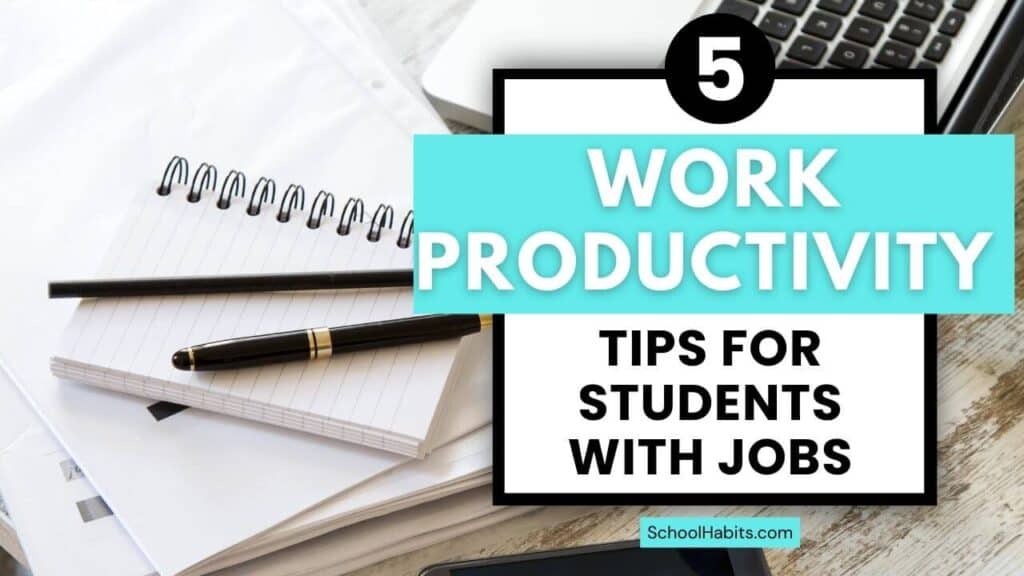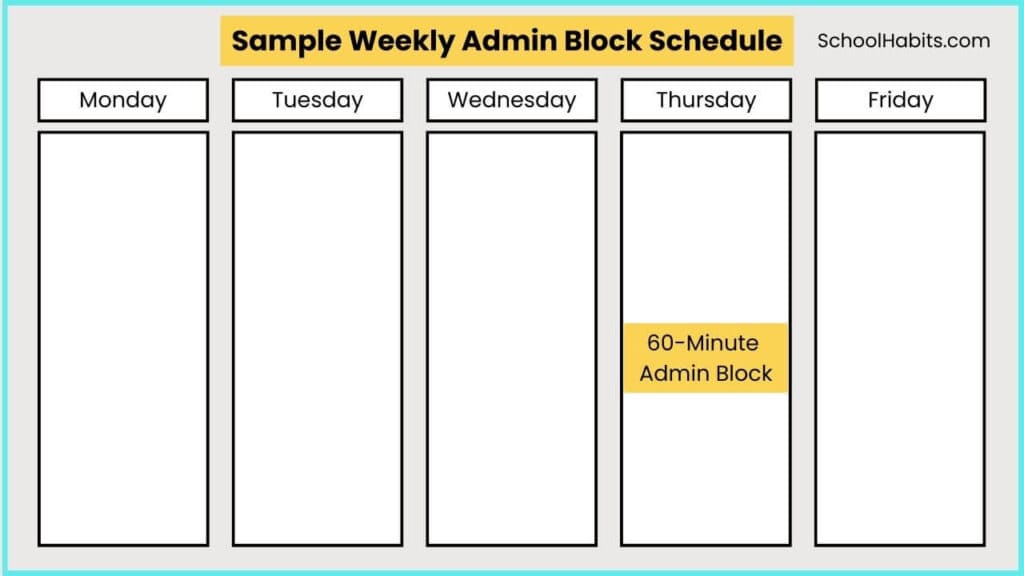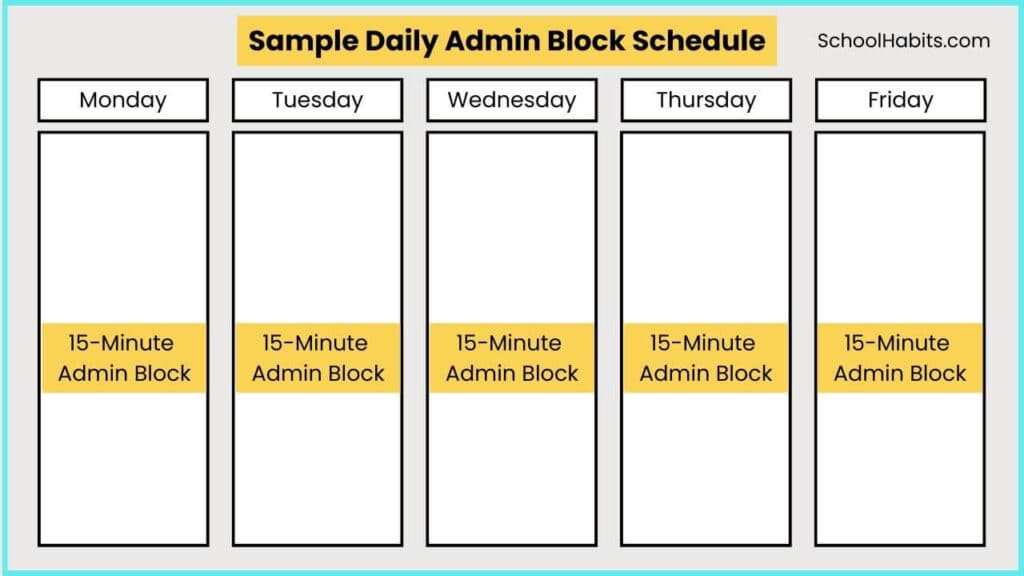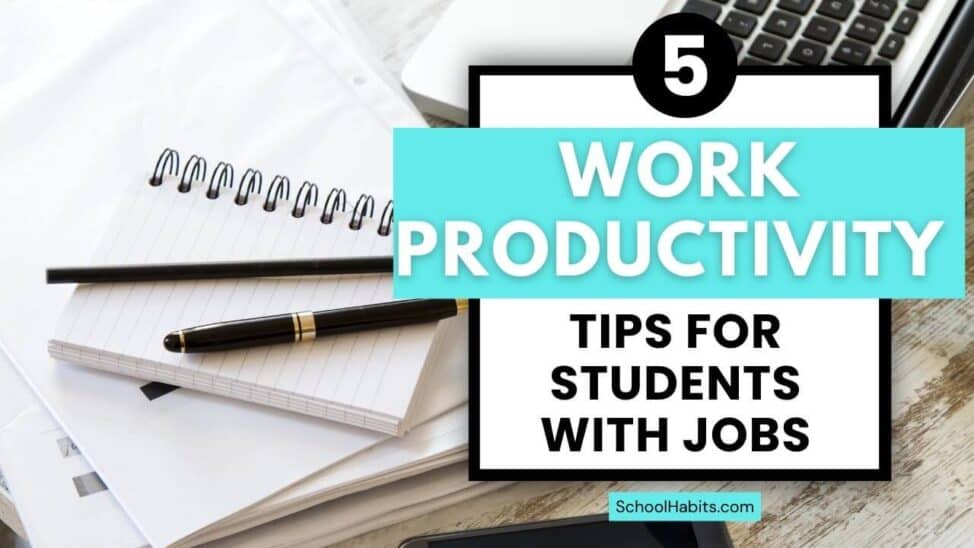
By Katie Azevedo, M.Ed.
You might be working full-time while pursuing a part-time undergraduate degree, or you might be working full-time while going to graduate school. Whatever the configuration or reason for working and going to school at the same time, it’s important that adult students maximize their productivity across both arenas.
I cover student productivity a lot on this blog, such as here and here. However, in this blog post, I share 5 work productivity tips for students with jobs. The strategies will maximize your productivity at work.
The tips below pair well with another blog post I wrote a while back, which is still completely relevant: How to Be More Productive at Work. I suggest you head there after you’re done here.
5 Work Productivity Tips for Students with Jobs
Important note: I want to make it very clear that I’m not teaching work productivity tips so that you can get more done in less time and therefore cram more onto your plate.
No way. That’s not my goal for you. And that is no longer the goal of healthy productivity. Instead, I’m teaching work productivity tips for students with jobs so that you can work more efficiently and effectively so that you can clear your schedule and keep it clear.
1. Schedule Regular Administration Blocks
All jobs come with administration tasks. Administration tasks are the daily things we need to do to keep everything around us running smoothly. They’re not necessarily in our job description, but we need to do them anyway. The big secret is that getting a grip on administration tasks enables us to do what’s in our job description.
The problem with administration tasks is that while they consume a considerable amount of time in our day, we often neglect to account for their true time cost.
When we spend our time playing whack-a-mole with work admin, we are left feeling overwhelmed, unproductive, and like we have no idea where time went. So, the goal is to be intentional about when you do these tasks.
What counts as admin will vary depending on what your job is. But below are some general examples of what might constitute as work admin tasks:
- Sending and replying to emails
- Making phone calls
- Following up with people
- Typing up meeting notes
- Organizing files
- Managing and filing data
- Managing calendars
- Cleaning and tidying workspace and work materials
The tip for increasing your work productivity is to schedule Admin Blocks into your day or week. Depending on your job, you might need a 15-minute admin block every day, or maybe one 60-minute block once a week. You’ll have to figure that out for yourself.
The important thing is that you do this intentionally. Make a weekly plan and schedule a definite time when you’re going to batch together and complete your admin tasks.
The following image shows an example of what various admin block schedules might look like over the course of a week.


2. Create a Simple and Reliable Task Management System
So much stress comes from not having clarity around what we need to do. Creating a simple and reliable task management system gives you total clarity on your to do list, which, in turn, relieves stress,
Task management systems don’t have to be fancy. They could be a simple paper planner, a basic to do list, or something more robust and digital like Asana. I use a combination of the free version of Asana and a paper planner.
The key to increasing work productivity is to use your task management system consistently, even on the days when you don’t think you need to. The more you use it, the more you will trust it, and the more you trust it, the more it will work.
Another productivity tip that has to do with task management is to use Status Notes for ongoing projects. I teach you all about Status Notes here. This is a simple strategy that you use whenever you need to temporarily walk away from a project that you plan to return to, either later that day or in a few days. A Status Note ensures that you can pick up exactly where you left off.
3. Manage Email Properly
Work emails can be the source of overwhelm and stress. That’s because many companies use email as their primary source of communication, no matter the message. In other words, you never know if you’re going to open your inbox to an email about a real work emergency or an email about the bagels in the break room. Talk about stress!
Without a proper email management system, you’ll likely fall on one end of the email spectrum: you’ll either check your email compulsively, afraid to miss something, or you’ll avoid your email altogether, which will result in chaos.
The work productivity tip for working students is to be intentional (dare I say ritualistic?) about when you check your email and what you do with the information inside it.
If you’re scheduling daily admin blocks, you can easily add “check inbox” to your list of admin tasks. But if you’re not scheduling daily admin blocks, you might consider checking your email at least twice a day. (Obviously, you might need to check email far more than that, depending on the nature of your job.)
Here are some tips for mastering your work inbox:
- Don’t use your inbox as a task management system.
- If you open an email and you can “handle” what’s in it in less than two minutes, handle it.
- If an email contains a question you don’t yet know the answer to, reply to the email with something like “I am working on getting you an answer, and I’ll follow up shortly.” Do not leave the person hanging.
- If the email contains information that you’ll need in the future, such as a date or a deadline, extract those details and add them to your calendar.
- If the email contains a task for you to do, extract the task and add it to your task management system.
- Read my tips for student email management if your school inbox is just as chaotic as your work inbox.
4. Stop Multitasking
Multitasking is a myth. You think you’re unique and can multitask, but what’s actually happening is that you’re rapidly switching back and forth between tasks. This rapid switching might feel like you’re doing two things at once, but it’s impossible to give full attention to two cognitively demanding tasks at the same time.
The problem is that when you rapidly switch back and forth between two tasks, you are unable to devote the required neurological resources to both tasks. Put simply, you do a junk job on both.
The work productivity tip is to start and complete one task before moving onto another.
Let’s look at an example. Let’s say that you’re working on creating a meeting agenda in Google Docs. At the same time, you’ve been waiting on your colleague to send you an email with her input about another project you’re working on, so you are checking your email every 5-10 minutes or so to see if her email came through. This creates a productivity disaster.
Instead, I want you to work on the meeting agenda from start to finish without a single distraction. When you’re done with the agenda, you can move onto checking your email. Or, an alternative is to set a timer for a specific work interval – say 25 minutes – and then check email with intention after the timer beeps.
Here’s an exercise for you: The next time you’re at work and you’re feeling frazzled and overwhelmed, pause, and ask yourself if you’re attempting the myth of multitasking. Do you have too many open projects that you’re bouncing between? Is your attention split between multiple tasks? If so, choose one to complete, and shut down the others Until you’re ready to give those your full attention.
5. Close Down Work Days with a Shut Down Routine
If you were a working student, it’s likely that you will often leave your place of work and head straight to class. In these moments, I know you’re rushed and you just need to go already.
But setting up and following a simple five minute shut down routine, before you leave work for the day can do wonders for your productivity.
As you’re nearing the end of the day, I want you to write down the following things before you clock out. You can do this in your task management system, or even on a simple sticky note:
- Open projects you started but haven’t yet completed (you can make a Status Note for each individual project)
- Your top three priorities for the next day
Additionally, take a moment to clear and clean your workspace. This simple shut down routine increases your productivity because it reduces the amount of time you spend transitioning back into work the following day.
Also, setting your priorities for the next day forces you to be clear about where to spend your time. We often just tackle the next item on our list without prioritizing — and this is a direct route to being unproductive.
The best work productivity tips for students with jobs are really centered around being intentional with what you’re doing and when you’re doing it. At the end of the day, that’s what productivity really is. It’s removing the distractions and working with concentration on the things that need to get done.
You can certainly apply the same principles to your schoolwork: being productive in school has the same advantages of being productive at work: less stress, less overwhelm, more control over what you’re doing, increased performance, and more time to spend doing the other things you want to do.

